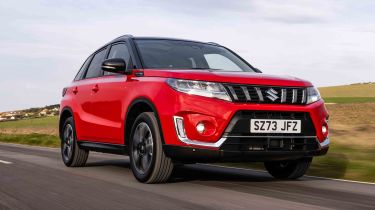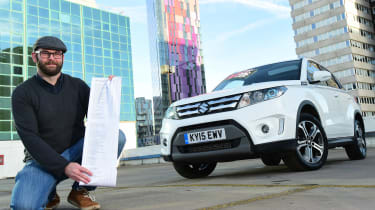Suzuki Vitara review: well-equipped but dated hybrid SUV
The Suzuki Vitara has transformed from a chunky off-roader into a softer crossover that's affordable and good to drive

Quick verdict
The Suzuki Vitara has been transformed from a utilitarian, family-friendly SUV into more of a crossover with sleeker styling and plenty of safety equipment. Optional all-wheel drive is available if you need it for additional traction in slippery conditions, and Suzuki offers attractive finance deals that may persuade some.
However, the Vitara is getting a little long in the tooth, and is no longer up with the class best. Its interior can’t match the plusher rivals, refinement isn’t great, and more spacious rivals are out there.
Our choice: 1.4 Boosterjet SZ-T
|
Key specs | |
|
Fuel type |
Petrol |
|
Body style |
SUV |
|
Powertrain |
1.4-litre, 4cyl, petrol plus MHEV, front-wheel drive 1.4-litre, 4cyl, petrol plus MHEV, four-wheel drive 1.5-litre, 4cyl, petrol plus 1x e-motor, front wheel drive 1.5-litre, 4cyl, petrol plus 1x e-motor, four-wheel drive |
|
Safety |
2015 rating expired |
|
Warranty |
3yrs/60,000 miles (up to 7yrs/100k miles with routine franchise dealer servicing) |
Suzuki Vitara: price, specs and rivals
The current Vitara arrived in 2015, and is a competitor against cars such as the Ford Puma, Peugeot 2008, Nissan Juke, Renault Captur, and a wave of other small crossovers that have joined the class since the Vitara's original release. As a result, the Vitara has gone through two updates to help keep it competitive. However, the Vitara’s closest rival might come from within, because the latest Suzuki S-Cross is bigger than the Vitara and doesn’t cost much more.
Most of the range is front-wheel drive, with the top-spec version gaining Allgrip four-wheel drive. This highlights the expectations of modern SUV buyers, who want the rugged looks and raised driving position of an SUV, but expect the running costs of a conventional hatchback.
Used - available now

2020 Suzuki
Vitara
44,287 milesManualPetrol1.4L
Cash £10,500
2019 Suzuki
Vitara
40,166 milesManualPetrol1.0L
Cash £9,400
2016 Suzuki
Vitara
19,128 milesManualPetrol1.6L
Cash £10,599
2016 Suzuki
Vitara
65,790 milesManualPetrol1.6L
Cash £8,400There are two engine choices; a 1.4 Boosterjet petrol engine with mild-hybrid electrical assistance, delivering 127bhp and 235Nm of torque, along with a 1.5-litre ‘Full Hybrid’ model, which replaces the automatic mild-hybrid and should slightly improve running costs. It’s not particularly fun to drive, chiefly due to a sluggish automated manual gearbox. Power stands at 113bhp and torque is a meagre 138Nm.
You can pick between two trim levels: SZ-T and SZ5. Entry-level SZ-T is very well equipped, with LED headlights, climate control, full smartphone capability, and a host of safety equipment, including blind spot monitoring, rear cross-traffic alert, plus a reversing camera. The range-topping SZ5 has keyless go, a panoramic sunroof, polished 17-inch wheels, and front and rear parking sensors.
If you can sacrifice a little ride comfort, and value driving dynamics more, the Vitara is a fine crossover that's quite car-like to drive. The Vitara’s hybrid-only line-up provides strong efficiency, with the 1.4 Boosterjet mild-hybrid engine in particular giving decent performance. Add in respectable finance deals, a responsive and agile chassis for the class, plus a generous safety kit list, and the Vitara looks to be a decent all-rounder. However, its refinement lags way behind the class best as does its dated-looking interior – especially considering that the range-topping model costs nearly £31,000.
Speaking of price, the Vitara starts at just under £25,500, which is more than the entry-level Nissan Juke, Renault Captur, and even the Volkswagen T-Cross. The Vitara is around the same price as the Toyota Yaris Cross, but is less than the Ford Puma.
Suzuki Vitara SZ5: long-term test
In 2016, our creative director, Darren Wilson, spent 10 months behind the wheel of a fully loaded SZ5 model. His car came with the highly economical diesel engine that was available at the time, providing frugal motoring for 8,000 miles.
That being said, he did find that engine noisy and agricultural. He also found that the interior quality wasn’t up to the class standard, and did, in fact, have some issues with loose trim during his ownership.
Engines, performance & drive
The lightweight Suzuki Vitara feels more eager to drive than some of its small SUV competitors, plus it has the option of four-wheel drive - a rarity in this class of car. It isn’t the most refined of small SUVs, and the 1.5 Hybrid model has a particularly lazy automatic gearbox that can’t match the smoothness of the Toyota Yaris Cross. Read more about the Suzuki Vitara's engines, performance and drive…
MPG, emissions & running costs
The most efficient Vitara is the 1.5 Hybrid with a fuel economy figure of 54.3mpg, making it more efficient than its petrol only rivals, but not quite as economical as the Toyota Yaris Cross. Residual values after three years/36,000 miles are decent, but the Vitara is likely to cost more than the Ford Puma and Yaris Cross to insure. Read more about the Suzuki Vitara's MPG, emissions and running costs…
Interior, design & technology
While the interior of the Vitara is well screwed together, logically laid out, and comes with plenty of equipment, it is full of hard and scratchy plastics that undermine the sense of quality versus much more premium-feeling rivals like the Skoda Kamiq. The touchscreen infotainment system in the Vitara isn’t the easiest to use. Read more about the Suzuki Vitara's interior, design and technology…
Boot space, comfort & practicality
The relatively boxy shape of the Vitara gives you plenty of headroom (the panoramic sunroof of the SZ5 does reduce this somewhat), but it doesn’t offer the most legroom in its class for adults in the back. The boot isn’t especially generous, with its 362 litres (289 litres for the 1.5 Hybrid) of capacity being outdone by some superminis. At least there’s plenty of room up front for a pair of six-footers, and lots of adjustment in the driving position. Read more about the Suzuki Vitara's boot space, comfort and practicality…
Reliability & safety
According to the latest Driver Power customer satisfaction survey information, the Suzuki brand has been slipping down the rankings. It’s also a shame that the 2015 Euro NCAP safety rating for the Vitara has expired because the test has become much more demanding in the intervening years. You get a lot of safety assistance technology as standard with the Vitara, most of which is an option with its rivals. Read more about the Suzuki Vitara’s reliability and safety…
Should you buy a Suzuki Vitara?
The Suzuki Vitara would suit someone looking for a well-equipped, efficient, and nice-to-drive small SUV. It’s also quite a bit shorter than some of its rivals, so the Vitara will be a little easier to parallel park on the street. You can get a four-wheel drive Vitara, which might be important to those living in isolated areas where gritters might not be able to get to if it snows.
However, it won’t suit those expecting the refinement you’ll find with a Skoda Kamiq, and its smaller size will most likely become an issue for families with growing teenage children or little ones you’ll need to put in bulky child seats. The Vitara also has no clever storage solutions, like the ‘Megabox’ in the Ford Puma, which allows you to carry a golf bag upright. You also can’t get an electric version, so company car drivers might want to consider alternatives like the Hyundai Kona Electric.









